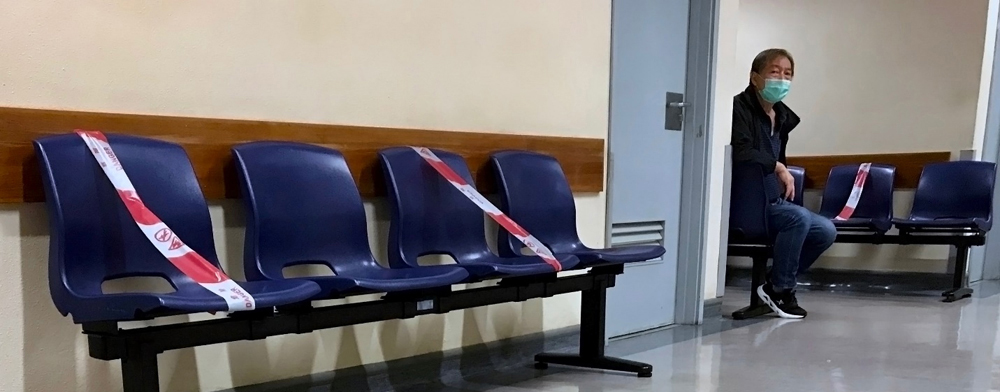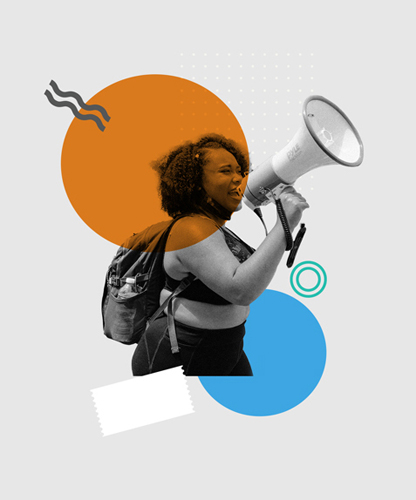Have you ever succumbed to truthiness? What are some ways to identify and critique its effects?
Why Is It Taking So Long? A Social Problem?


Imagine you are sitting in a hospital waiting room because you have a stomach ache. You arrived at the hospital emergency room at 2 a.m., registered, and sat down to wait. It is now 3:30 a.m. You have been moved to another room, but you’re still waiting. You’re weary and frustrated. Why is this taking so long? Why are “they” so “slow”?
You may have asked these questions or similar ones in different scenarios, whether it was waiting for a bus, standing in a queue, or making a call. Why is it taking so long? Why are “they” so “slow”? But have you gone further to think through what might cause such a delay. Is it just that the workers are “too slow”? Or could other issues be the cause? Perhaps the hospital staff are overstretched and lacking resources. As you try to make sense of the scenario, ask yourself: what assumptions are embedded in how you understand the situation? The scenario above reminds us that we all make assumptions, especially when trying to understand and solve problems. This doesn’t mean our assumptions are always correct, a topic we will explore further in this module.
If many other people are experiencing a problem, such as delays at the hospital, an issue may be more than just an individual problem. It may be a social problem, something which affects a population more widely. This module asks us to look at the problems we encounter in our everyday lives and ask, Is there more to this story? Are others experiencing these problems too? How come? And how can we address this?
Social Problems and the Sociological Imagination

In order to understand how our individual problems, such as being stuck in a hospital waiting room, might be understood in a wider context, we can use what C. Wright Mills (1959) calls the sociological imagination. The sociological imagination is a way to link the things that trouble us individually with bigger problems in society’s social structure or in how society is organized. (You learned about social structure already in the last module.) For Mills (1959), the sociological imagination distinguished between personal troubles and public issues. Personal troubles, or individual problems as we’ll call them, are things that happen in our individual experience or to the people around us. In contrast, public issues, or social problems as we’ll call them, are “matters that transcend these local environments of the individual and the range of [one’s] inner life” (Mills, 1959, p. 9). With public issues or social problems, Mills wanted us to reflect on and analyze society’s social structure. Thus, the sociological imagination allows us to think about how changes in social structure may affect our personal experiences. More than this, we can use it as a methodology for conceiving of and understanding social problems.
How does this work? Using the sociological imagination requires us to take a step back from the way we normally try to understand the world—through our personal knowledge and experiences. Instead, we try to see and understand how society is organized to recognize the social problems or issues that affect people’s everyday lives. It’s important to remember that just because we believe something to be true doesn’t make it so (see Go Deeper). When we use the sociological imagination, we collect data, do research, and analyze our findings. Most importantly, we use our critical thinking skills. We try to see beyond our own standpoint—and the prejudices and assumptions we might hold—to formulate what social problems are, why they exist, and how we may act to create positive, lasting solutions that help as many people as possible.
In this way, using the sociological imagination is an important aspect of global citizenship.
Go Deeper
Truthiness, Assumptions, and Social Problems
Comedian and talk-show host Stephen Colbert developed the concept of truthiness to describe how something can seem true to us because we strongly feel or believe it is. This concept allows us to reflect on assumptions we make and ways we view the world that may not be based in fact.
Watch the video to get a sense of the concepts of truthiness and “post-truth.” (Source: The Late Show with Stephen Colbert, 2016)
After watching the video, answer the following questions:
- What is truthiness and “post-truth”?
- How do you think truthiness and “post-truth” are related to stereotypes and prejudice?
- Why is thinking about a social problem in terms of “a gut feeling you have” dangerous?
The discussion about truthiness and post-truth is very relevant to the discussion on “fake news” you will see here and in the Social Media and Disinformation module. Should you decide to read ahead, consider the assumptions embedded in “fake news,” who produces it, as well as the viewpoints about the world and people it promotes.
Individual Problems vs. Social Problems
Understanding the distinction between individual problems and social problems can help us find deeper explanations for why we experience the world the way we do. It gets us to reflect on our experiences and how they are related to how society is organized and works. It reminds us to analyze where our problems come from and how they may impact people beyond us. This allows us to avoid making assumptions in shaping our answers.

So how do individual problems and social problems differ?
Individual problems may look like individual misfortune or unluckiness. Consider the example of job loss and unemployment (Mills, 1959, p. 10). That you or someone you know lost their job is an example of an individual problem. It’s something that a single person, or a few individuals, experience. When understood in this way, the problem can be resolved through individual action: find another job.
Social problems, on the other hand, are collectively experienced by people. They aren’t the sort of thing that individuals can resolve on their own. For example, if many people are experiencing unemployment, or statistics show high unemployment, this suggests that people are increasingly losing their jobs and having trouble finding new ones. If we look at this as a social problem rather than an individual problem, we reflect on how the structure of society is creating unemployment and hardship for people. And to resolve this problem, we may need to change how society is structured. This will require collective effort and responses from public institutions such as government, as well as corporations.
Ultimately, social problems impact individuals. On the other hand, individual problems may not necessarily be linked to social problems.
Think of an everyday problem you face. Can the sociological imagination help you figure out whether your everyday troubles can be connected to a social problem?
Go Deeper
COVID-19 and Employment in Canada
Have you considered how the COVID-19 pandemic may have affected employment and unemployment? Have a look at Statistics Canada information from July 2020 here. (Source: Statistics Canada, 2020)
After looking at the data, think through the following questions:
- Explain why losing a job during the COVID-19 pandemic should be considered an individual or social problem.
- Whose responsibility is it to resolve this problem?
- How does the pandemic make you think about how the job market is structured? How could it be made fairer?
But… What Is a Social Problem?
While the last sub-topic highlighted the differences between individual and social problems, you may still be wondering how to spot or identify a social problem. The list below gives key characteristics of social problems.
The Characteristics of Social Problems*
- A social problem exists when there is a sizeable difference between the ideals of a society and its reality.
- An issue only becomes a social problem when people have been able to convince others that it requires public attention and collective action.
- Power and exposure influence the extent to which people can be convinced a given issue is a social problem.
- Social problems are determined not just by the number of people they affect but by how they affect them.
- Defining a social problem involves convincing the public that both the causes and solutions for a problem lie beyond individual responsibility.
*This list contains material from “Week 2: Social Analysis Part 1,” by Selom Chapman-Nyaho, in the GNED 500 online course content © Centennial College.
This list of characteristics shows us that identifying and defining a social problem is no easy matter. It requires an ideal vision of society. Others have to be convinced it exists and requires action. It can’t only have consequences for a group of people, but it must also affect them in particular and specific ways. Finally, in persuading others, one must also be ready to make the case why it’s not problem a person has responsibility to resolve individually.

These characteristics highlight the role we play in constructing social problems. This doesn’t mean that they don’t exist, or that we make them up out of thin air. It means that to recognize them and resolve them in meaningful ways, we need to think through what a social problem is and justify our reasoning. This may require doing quality research on our social problem, so we can talk about it with depth, using facts.
Take, for instance, the issue of police power, violence, and racism. You may have heard about this issue early in the COVID-19 pandemic when George Floyd and Breonna Taylor were killed by police in the US. It also arose in Canada with the deaths of Ejaz Choudry (Gamrot, 2020) and Regis Korchinski-Paquet (CBC News, 2020).
On first look, it may appear that in these cases, police violence is an individual problem. It affects only a few people. If we think of it this way, we can imagine that individuals can resolve this problem through individual action: acting differently the next time similar situations arise. But what if we start to see this as a pattern? As stories of police violence and racism continue to be told throughout Canada and the US, we must consider whether this is a social problem that requires further investigation and changes to how society is organized (its social structure) to ensure no one else dies. We must ask: can individuals alone end police violence?
If the answer to this question is no, the sociological imagination becomes useful. We can use it to consider whether a so-called individual problem (a death by police) may be part of a broader social problem (police violence and racism). To do this, we will want to think through how police and policing function and are structured within and as part of society. This may lead us to ask questions such as:
- What is the history of policing?
- What are the functions of police?
- How and why are people affected by police violence?
- What type of power do police hold?
- What does this tell us about policing?
By thinking through these questions, we will eventually be able to identify if this is a social problem and why. This will allow us to engage in a social analysis [see module on social analysis] to figure out what can be done to address and resolve the problem.
Go Deeper
Police Violence in Canada
In Canada, we like to believe that American social problems only exist “over there” and that we don’t have our own unique versions of them. In this blogpost, activist-journalist Desmond Cole highlights and links to articles about victims of police violence in Canada and reminds us that many of these problems are “over here” too. (Source: Cole, 2020)
A Sample List of Social Topics or Issues
Here is a sample list of topics or social issues that may help you think through what social problems could be. Remember, you’ll need to be able to talk about why these topics or social issues are social problems and be able to talk about your topic as a social problem. Sometimes a social issue may be too broad to think about as a social problem. You can narrow your focus by thinking through more specific aspects of your topics. This is how you arrive at a topic that might be explored as a social problem.
LIST OF TOPICS
Unemployment
Climate Change
Wage inequality
Affordable childcare
Oil production
Waste disposal
Social assistance provision
Anti-Black racism
Indigenous-settler reconciliation
Islamophobia
Let’s practise turning one of these broad social issues into a topic that we can explore as a social problem. Take the topic of wage inequality. This is a vast topic. It’s too broad to look at as a social problem. Imagine trying to resolve wage inequality for every person experiencing it in the world. Would the same set of solutions work for them all? Of course not. Because, while we may be connected throughout the world by globalization and a capitalist economic system, the root causes of the wage inequality people are experiencing will vary. These causes depend on context, location, and social group.
To examine a broad social issue as a social problem, you need to narrow it down in terms of geography and a group of people you are interested in knowing more about. Let’s say you choose the geographical region of Canada, and your group is women. This could lead your topic to focus on gender wage inequality in Canada—here, you’ve narrowed your broad topic to a more manageable one. Now you can start to research your topic more specifically, so you can find the root causes. You could also look at racial wage inequality in the UK. Or you could think through the topic of income disparities between those living in rural Canada and those living in cities. Remember selecting a topic isn’t enough. You need to go deeper and think through what aspect of the topic you’re interested in and research it, in order to think about it in terms of a social problem.
Social Problems in Context
To understand a social problem, we can’t simply look around us to see how it shows up in our everyday lives. We have to go deeper. Our understanding of social problems is socially constructed—that is, it is shaped by historical, economic, political, and cultural forces.
The sources of information we use to understand social problems matter. This is because different sources have different biases and will tell us different things about a social problem. Let’s say you wanted to know more about minimum wage to explore the social problem of growing economic inequality in Canada. You may find relevant research from think tanks, but think tanks produce information from a certain political view. So the research on minimum wage produced by the social democratic and social justice–oriented Canadian Centre for Policy Alternatives (n.d.) will differ from that produced by the conservative, free-market-oriented Fraser Institute (Murphy, Lammam, & MacIntyre, 2016).
Keep in mind that if you kept your research problem as broad as this (studying all of Canada), your analysis of the social problem may not be as rich or interesting! Narrowing your focus to look at provinces, cities, or demographics might reveal different things. In doing this, you may find that the context of your research has changed and that the roots of the social problem you’re studying are far more complex than you might have imagined.
Furthermore, as feminist and anti-racist historians have pointed out, our understanding of history is told from the perspective of powerful white men. We know a great deal about Christopher Columbus but very little about the people whose land he took over and were massacred. Elementary students continue to learn about the heroic acts of European settlers but little about the experiences of First Nations who already lived on this land and experienced cultural genocide and deaths in residential schools. This reminds us that knowledge is not neutral. What we know and what we are able to know are shaped by our sources of information. This in turn affects what we know about social problems and how we act in relation to them. Our understanding of social problems is always shaped by history, politics, and culture.
Go Deeper
Think Tanks and Research
Below is a list of some think tanks and organizations that produce research on various social problems:
| THINK TANK / ORGANIZATION | LINK |
| Canadian Centre for Policy Alternatives | https://www.policyalternatives.ca/ |
| Fraser Institute | https://www.fraserinstitute.org/ |
| Toronto Region Immigrant Employment Council | https://triec.ca/ |
| International Labour Organization | https://www.ilo.org/global/lang–en/index.htm |
| United Way Greater Toronto | https://www.unitedwaygt.org/home |
| C.D. Howe Institute | https://www.cdhowe.org/ |
| Broadbent Institute | https://www.broadbentinstitute.ca/ |
| Wellesley Institute | https://www.wellesleyinstitute.com/ |
Summary
In this module, we learned about social problems to help us make a link between our everyday experiences and broader social issues that arise because of how society is structured. We also noted how assumptions can colour how we view social problems and ultimately whether we decide to act on them. We thought about how to formulate social problems from topics of interest. Thinking about social problems helps us engage in big-picture thinking and reflective practices—key aspects of global citizenship. Now that you understand and can think through social problems, you are well prepared to begin a social analysis, which is tackled in the next module.
Key Concepts
Key Concepts
individual problems
Problems typically experienced by few people; problems that can be linked to individual misfortune. Individual problems may be resolved by individuals.
institutional problems
Social problems caused by institutions. Fixing the institution, it is believed, will resolve the problem.
methodology
An approach or framework used to make sense of phenomena, issues, or problems.
power
The ability to construct how ideas or groups are represented through the organization of meaning (e.g. whether one describes a particular armed person as a terrorist or a freedom fighter). In other words, having power means setting the terms and conditions within which people and groups are able to act in a particular context.
prejudice
A “preconceived opinion that is not based on reason or actual experience” (“Prejudice,” n.d.).
social problems
Problems that affect groups of people and are caused by how society is structured and organized. Social problems are particular to specific societies and times. Solutions to these problems are beyond the reach of any single individual.
social structure
The arrangement of social institutions into relatively stable patterns of social relations. The way a society is organized.
sociological imagination
An approach developed by C. Wright Mills that links everyday problems individuals experience to the greater context of social issues in order to understand the roots of those social issues.
standpoint
A perspective adopted by a person based on their specific individual experiences and circumstances.
systemic/structural problems
Problems caused by how society is structured and organized. Understanding social problems as systemic/structural problems acknowledges that resolving them is incredibly difficult but creating change through social action (based on the principles of global citizenship) is meaningful and can be long-lasting.
think tanks
Organizations that produce research based on particular political principles. Think tanks have a variety of political views and so provide a variety of perspectives.
Global Citizenship Example
Researching social problems will inevitably lead you to finding multiple perspectives on the same issue. Which is the correct answer? Which reveals the absolute truth?
First, it is important to understand there is no correct way to figure out the truth. Understanding that, we still must try to step back from the assumptions we hold about an issue. Take the introduction example of waiting in line at a hospital. Did you make certain assumptions about who is to blame? Did you consider why the issue or problem arose in the first place?
Just as the sociological imagination requires us to make connections between everyday problems and how society is structured, global citizenship asks us to refuse simple answers to everyday problems by seeing them in a larger context. When we make connections between our experience and the experiences of others, we are thinking like global citizens. This is big-picture thinking at work.
And when we do research to learn more about social problems, we are engaged in reflective practices. What happens if our assumptions are challenged? Do we accept the findings of strong research conducted by others, or do we hold on to our assumptions because we believe them to be true? In these moments, we face cognitive dissonance. Cognitive dissonance refers to the tension that results from holding two different beliefs or from struggling with new information in light of past knowledge (Gorski, 2014). But by letting go of our assumptions about issues and problems, we can gain clarity on important issues and work towards justice and action. Getting to the root of social problems is the first step to resolving them.
Indigenous Example

In September 2020, an Indigenous woman, Joyce Echaquan, lying in a Quebec hospital, took a Facebook video recording hospital staff making racist remarks towards her. Shortly after taking the video, she died (Barrera, 2020). In 2008, an Indigenous man in a Winnipeg, Manitoba, hospital died in a wheelchair while waiting for care in the emergency room. Healthcare workers had assumed the man, Brian Sinclair, was drunk or “homeless and had come [in] to avoid the cold” (Geary, 2017). An inquest into his death failed to address key aspects of Sinclair’s story, including what role racism in the healthcare system played in his death (Geary, 2017).
These stories might initially strike us as one-off incidents. But are they?
These are not the only stories of Indigenous-specific cases of racism in the Canadian healthcare system. Alisa Lombard, a lawyer based in Saskatchewan, is leading a proposed class action lawsuit to represent Indigenous women who were either coerced or forced into sterilization. As Lombard says, this is “symptomatic of a colonial hangover. And I think it has a lot to do with eugenics of course, these ideas that some people should have children and others are not fit to” (Ward, 2020). This might lead us to think through the effects of the continuing legacy of colonialism and the racism in the Canadian healthcare system, and how these affect Indigenous well-being and vitality in Canada.
Research also suggests we may be looking at a social problem. British Columbia’s government decided an independent investigation was needed into Indigenous-specific racism within BC’s healthcare system (Wyton, 2020). An attempt to provide context for Indigenous-specific racism in Canadian healthcare was tackled by the Wellesley Institute in a report titled First Peoples, Second Class Treatment (Allan & Smylie, 2015). Tang and Browne (2008) have also explored the effects of Indigenous stereotypes and racism in accessing health care.
All this reminds us that social problems may look like individual problems at first, if we don’t put them in context or do research. We have to look beyond what may seem like isolated cases. Researching an issue can allow us to think through whether and how a social problem exists.
Critically Thinking About Social Problems
There are three ways to view problems. The first is as individual problems. Individual problems, as you’ll recall from earlier sub-topics, view individuals as the source of their problems. And it is the individual who needs to play an active role in resolving the problem.
The other two ways to view problems relate to social problems. However, they frame social problems differently.
One way to view social problems is as failures of public institutions, or institutional problems. Public institutions are funded and/or regulated by the government and provide services to the public [see the module on Social Structure and Institutions; Sub-topic 2:Institutions. Examples of these include public libraries, the education system, and the banking system. When we view social problems in this way, we’re suggesting that if these institutions did a better job, social problems wouldn’t exist.
The other way social problems can be understood is as systemic and structural, or systemic/structural problems. Through this lens, social problems arise due to the way society is organized politically, economically, historically, and culturally. To resolve social problems, then, requires a deep exploration of how society functions and how its structure allows these social problems to emerge and continue to exist.
How a social problem is framed and viewed will affect how we try to resolve it.
To help illustrate these three ways to view problems, let’s take the example of youth unemployment. Take a look at the chart below. Do you see how the same issue gets taken up in different ways, based on different assumptions, and may lead to entirely different solutions?
Youth Unemployment
| Type of Problem | How the Problem Gets Viewed | Assumptions Made by the Problem Type |
| Individual Problem | • “Today’s youth are entitled and lazy. They expect too much.” • “We must take for granted that good jobs are a thing of the past. The new reality is that work is unstable, low paying, without benefits or pensions.” • “There are jobs out there; if you try really hard you will find work.” | • Individuals just have to get used to the way the labour market is now. • If you’re not finding work, it’s really your fault for not looking hard enough, or not having a good enough resume. • Individual youth need to be less picky about the jobs they’ll take. • This framing assumes that the individual must solve the problem on their own. |
| Institutional Problem | • “Students are being shortchanged by the educational system. Schools don’t adequately prepare students with appropriate skills and knowledge for the job market.” | • If the education system better prepared youth for the labour market, there would be no youth unemployment. • This framing assumes that fixing a public institution will solve the social problem for everyone. |
| Systemic / Structural Problem | • “Young people are underemployed in many sectors of the economy because government policies favour profits for the corporate sector at the expense of the general public. Contributing factors include government cutbacks and outsourcing along with corporate downsizing, deskilling and union bashing. Hence, low paying, unstable and temporary jobs, where many people and particularly youth are vulnerable to becoming the working poor.” | • A number of different factors, which at first glance may not seem related, come to create the social problem of youth unemployment. • This framing assumes that the roots of the social problem run deeper than any one thing, but rather are a product of how society is organized. |
Thinking of problems as individual or institutional seems to lead to simple solutions to solving them. But when you look at a social problem as systemic and structural, solving it becomes a lot tougher and more complex. Therefore, how a social problem is framed is political. When a social problem is identified as an individual problem, this may be a way to dismiss a bigger problem. By simply saying the individual can solve the problem for themselves (i.e. by actively searching for work), no deeper understanding of the problem or issue is needed. On the other hand, when a problem is framed as structural, any response will require significant and collective effort and change to how society works and is organized.
Sources
Licenses
Social Problems in Global Citizenship: From Social Analysis to Social Action (2021) by Centennial College, Kritee Ahmed is licensed under a Creative Commons Attribution Non-Commercial Share-Alike License (CC BY-NC-SA 4.0) unless otherwise stated.
Introduction photo by Toa Heftiba on Unsplash.
References
This module contains material from “Social Analysis for Social Change” and “Applying Concepts and Frameworks of Social Analysis,” by Chet Singh, in Global Citizenship: From Social Analysis to Social Action © 2015 by Centennial College. It also contains material from “Week 2: Social Analysis Part 1” by Selom Chapman-Nyaho, in the GNED 500 online course content © Centennial College.
Allan, B., & Smylie, J. (2015). First peoples, second class treatment: The role of racism in the health and well-being of Indigenous peoples in Canada. Wellesley Institute. https://www.wellesleyinstitute.com/publications/first-peoples-second-class-treatment
Barrera, J. (2020, October 1). Criminal investigation needed into death of Joyce Echaquan, say 2 legal experts. CBC. https://www.cbc.ca/news/indigenous/joyce-echaquan-death-lawyers-investigations-1.5745587
Canadian Centre for Policy Alternatives. (n.d.). Raising Ontario’s minimum wage. https://www.policyalternatives.ca/newsroom/updates/raising-ontarios-minimum-wage
CBC News. (2020, May 30). Thousands rally in Toronto to protest racism in wake of the death of Regis Korchinski-Paquet. https://www.cbc.ca/news/canada/toronto/protest-toronto-regis-korchinski-paquet-1.5591745
Cole, D. (2020, April 17). Remembering 27 Black, Indigenous, and racialized people killed by police. Cole’s Notes. https://thatsatruestory.wordpress.com/2020/04/17/remembering-27-black-indigenous-and-racialized-people-killed-by-canadian-police/
Gamrot, S. (2020, July 14). How the death of Mississauga man Ejaz Choudry helped spark a provincewide conversation about police reform. The Toronto Star. https://www.thestar.com/news/gta/2020/07/14/how-the-death-of-mississauga-man-ejaz-choudry-helped-spark-a-provincewide-conversation-about-police-reform.html
Geary, A. (2017). Ignored to death: Brian Sinclair’s death caused by racism, inquest inadequate, group says. CBC. https://www.cbc.ca/news/canada/manitoba/winnipeg-brian-sinclair-report-1.4295996
Gorski, P. (2014). Cognitive dissonance: A critical tool in social justice teaching. EdChange. http://www.edchange.org/publications/cognitive-dissonance.pdf
Mills, C. W. (1959). The sociological imagination. Oxford University Press.
Murphy, R., Lammam, C., & MacIntyre, H. (2016, March 3). Raising the minimum wage: Misguided policy, unintended consequences. Fraser Institute. https://www.fraserinstitute.org/studies/raising-the-minimum-wage-misguided-policy-unintended-consequences
Prejudice. (n.d.). In Lexico. https://www.lexico.com/definition/prejudice
Statistics Canada. (2020, August 7). Labour force survey, July 2020. https://www150.statcan.gc.ca/n1/daily-quotidien/200807/dq200807a-eng.htm
Tang, S. Y., & Browne, A. J. (2008). ‘Race’ matters: Racialization and egalitarian discourses involving Aboriginal people in the Canadian health care context. Ethnicity and Health 13(2), 109–127.
The Late Show with Stephen Colbert. (2016, July 19). Post-truth is just a rip-off of ‘truthiness’ [Video]. YouTube. https://youtu.be/Ck0yqUoBY7M?t=303
Ward, D. (2020, April 7). Forced sterilization a symptom of “colonial hangover” says lawyer. APTN. https://www.aptnnews.ca/facetoface/forced-sterilization-a-symptom-of-colonial-hangover-says-lawyer/
Wyton, M. (2020, July 20). Turpel-Lafond promises in-depth probe of anti-Indigenous racism in BC health care. The Tyee. https://thetyee.ca/News/2020/07/10/Turpel-Lafond-Promises-In-Depth-Probe-Anti-Indigenous-Racism
Social Problems
Kritee Ahmed